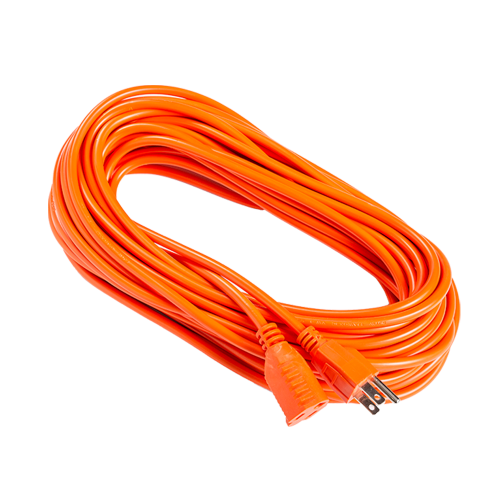Indoor extension cords can be classified based on various factors such as length, gauge (wire thickness), number of outlets, and additional features. Here are some common classifications of indoor extension cords:
Length: Indoor extension cords come in different lengths to accommodate various needs. They can range from a few feet to several yards long. Common lengths include 6 feet, 10 feet, 15 feet, 25 feet, and 50 feet. Choose a length that allows you to reach the desired power source without excess cord that may create a safety hazard.
Gauge: The gauge of an extension cord refers to the thickness of the wire inside. Thicker wires have lower gauge numbers and can handle higher electrical loads. Typical gauges for indoor extension cords are 16 AWG (American Wire Gauge), 14 AWG, and 12 AWG. Consider the wattage requirements of the devices you plan to connect and choose an appropriate gauge to ensure safe and efficient power delivery.
Number of Outlets: Indoor extension cords can have a single outlet or multiple outlets, commonly referred to as power strips or surge protectors. Power strips with multiple outlets allow you to connect multiple devices simultaneously. Some power strips may also include USB ports for charging devices such as smartphones or tablets.
Cord Color and Design: Extension cords come in various colors, including white, black, gray, and bright colors. Consider the aesthetics of your indoor space and choose a cord color that blends well or matches your decor. Additionally, some extension cords have a flat or low-profile design, which can help with cable management and prevent tripping hazards.
Safety Features: Certain indoor extension cords may include safety features to protect against electrical hazards. These can include built-in circuit breakers or surge protectors that guard against power surges or overloads. Look for cords with UL (Underwriters Laboratories) or ETL (Intertek) certification, which ensures they meet safety standards.
Specialized Cords: In some cases, you may require specialized indoor extension cords. These can include cords designed for outdoor use (if you plan to use them temporarily indoors and outdoors) or cords with specific features like locking connectors, retractable reels, or heavy-duty construction for demanding applications.
It's important to choose an indoor extension cord that is appropriate for your specific needs, ensuring that it can handle the electrical load and is compatible with the devices you plan to connect. Always prioritize safety by following manufacturer's guidelines and considering any applicable electrical codes or regulations.Meanwhile,Indoor extension cords are versatile tools that provide additional reach for electrical devices and enable flexibility in arranging and powering various appliances and electronics. Here are some common applications of indoor extension cords:
Powering Electronics: Indoor extension cords are commonly used to power electronics such as televisions, computers, printers, gaming consoles, and audio systems. They allow you to position these devices in convenient locations within a room without being limited by the proximity of power outlets.
Lighting: If you have lamps or light fixtures that are not located near an outlet, indoor extension cords can be used to extend the reach of the power source. This allows you to position lighting fixtures in different areas of a room, creating desired lighting effects or overcoming limitations in the placement of existing outlets.
Home Office Setup: With the increasing number of electronic devices used in home offices, extension cords become essential for managing cables and providing power to multiple devices. They allow you to connect computers, monitors, printers, scanners, and other office equipment to a power source efficiently and conveniently.
Kitchen Appliances: In the kitchen, extension cords can be used to power small appliances like blenders, toasters, coffee makers, electric grills, or food processors. They offer flexibility in positioning these appliances on countertops or islands without relying solely on limited outlet availability.
Holiday Decorations: Indoor extension cords are particularly useful during festive seasons when you may have various holiday decorations requiring power. They allow you to connect and power string lights, lighted ornaments, electronic displays, and other decorative items, creating a festive atmosphere throughout your home.
Workshop or Garage: If you have a workshop or garage space where power outlets may be limited, indoor extension cords can be used to bring power to tools and equipment. Whether it's powering electric saws, drills, air compressors, or charging stations for power tools, extension cords provide the necessary reach to ensure efficient workflow.





 English
English русский
русский















